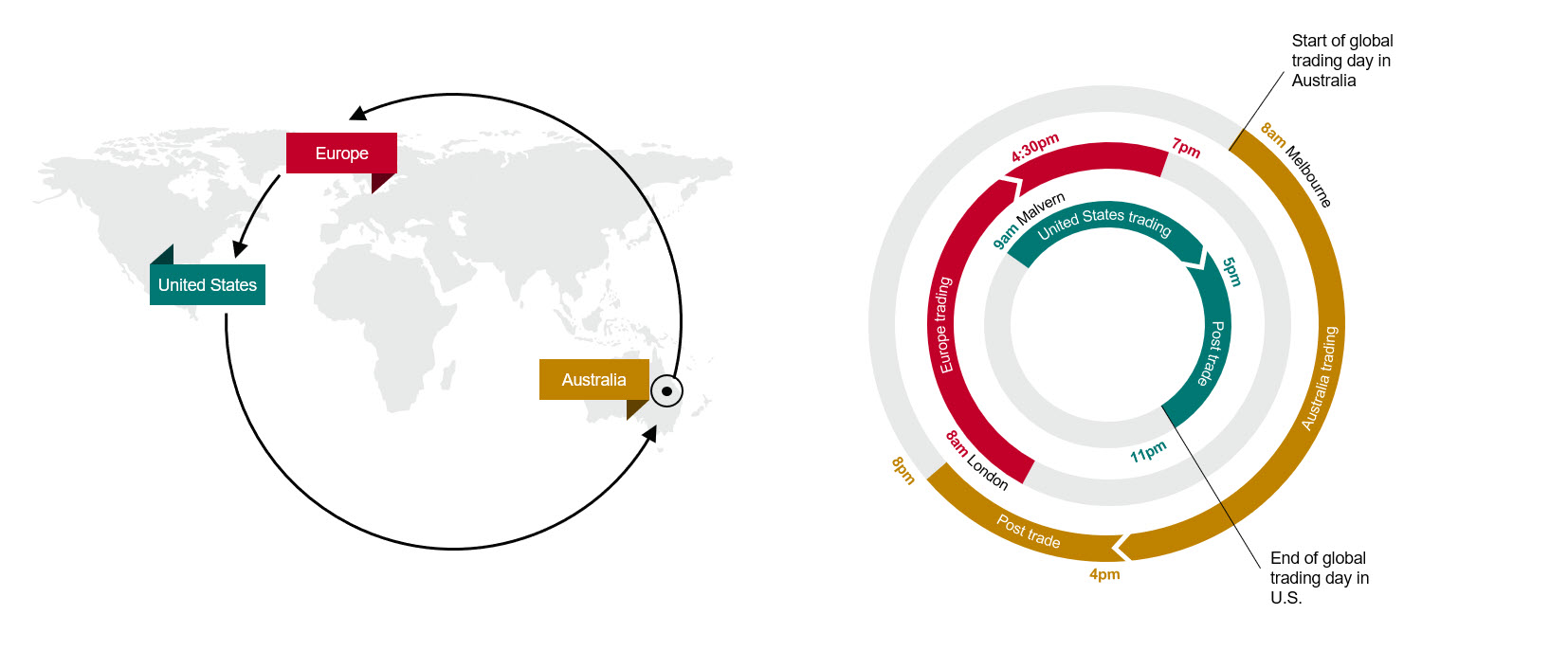Este artículo está disponible sólo en inglés.
At Vanguard, we manage $2.7 trillion of fixed income AUM globally, making us one of the largest fixed income asset managers[1] .This size comes with its advantages, such as access to a large global team and scale, which allows us to reduce transaction costs. More importantly, our size makes us a Tier 1 client for our counterparties, and we have spent decades building strong relationships with market participants. Therefore, when there is a market event, we have the expertise and relationships to effectively navigate volatility and deliver best-in-class client outcomes.
Vanguard’s index management is powered by an experienced team of more than 200 professionals located across the US, Europe and Australia[2]. This broad presence enables Vanguard to provide full coverage of global market open hours, respond quickly to local events and implement strategies that reflect the nuances of different regions and asset classes.
Our global teams are made up of traders and credit analysts who specialise within their individual sectors. Each credit analyst has close relationships with issuers in their sector and a deep understanding of issuer fundamentals. The close collaboration of these analysts with the sector-specialist traders helps us arrive at outcomes that reflect credit fundamentals and best execution. The result is more resilient and efficient portfolios, leading to tight tracking error for investors.
Global centres tap local expertise
24-hour coverage from three investment centres

Source: Vanguard. Diagram is provided for illustrative purposes only.
Data-driven insights: The bedrock of informed investing
In rapidly evolving markets, investment decisions should be based on robust, real-time data. Vanguard’s partnerships, both with trading platforms and other data providers, allow us to gain data-driven insights to assess the path for best execution.
These insights range from information on new deals to changes in book sizes, as well as further transparency into European and sterling markets. For more illiquid markets or securities, these data inputs can provide clarity on how the bond has traded during different time periods and how deep the market is. This information then helps us determine the optimal order size for a trade and which counterparty historically has offered the lowest cost.
Expertise in trade and execution: Precision that drives performance
With index investing, transaction costs are one of the key threats to tracking error. Effective trade and execution strategies are critical to minimising costs, which is why at Vanguard we take a sampling approach to fixed income indexing. Through a sampling approach, rather than buying every single bond in a benchmark, we aim to buy enough bonds to mimic the risk and return profile without incurring more transaction costs than necessary.
Given the sampling approach, there are many active decisions that need to be made as part of the process – indexing is anything but passive. These decisions are made in collaboration with traders, portfolio managers and our in-house credit research team, which provides in-depth, fundamental research. Having this research at our fingertips allows the traders and portfolio managers to select the issuers and securities for the sampling process.
Once the securities have been selected, the traders must decide the best strategy for execution to minimise transaction costs. This is where the data-driven insights come in. We aim to gather as much information as possible around liquidity, depth of market and counterparty selection and interpret this data to gain an edge over our competitors.
It's this combination—expertise in selection decisions coupled with data insights for execution—that allows us to provide superior outcomes for investors.
Optimisation versus full replication for an indexed portfolio
Striking the balance between tracking error and the cost of investing

Source: Vanguard. The chart is provided for illustrative purposes only.
[1] Source: Vanguard, as 30 September 2025.
[2] Source: Vanguard, as at 31 December 2024.